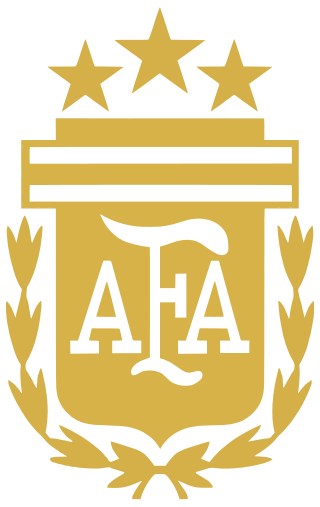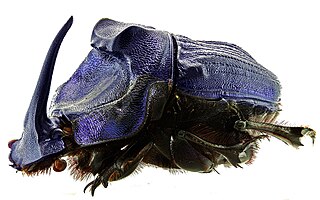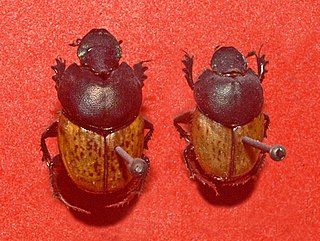
The Argentina national football team, nicknamed La Albiceleste, represents Argentina in men's international football and is administered by the Argentine Football Association, the governing body for football in Argentina.

The scarab beetle subfamily Scarabaeinae consists of species collectively called true dung beetles. Most of the beetles of this subfamily feed exclusively on dung. However, some may feed on decomposing matter including carrion, decaying fruits and fungi. Dung beetles can be placed into three structural guilds based on their method of dung processing namely rollers (telecoprids), dwellers (endocoprids) and tunnelers (paracoprids). Dung removal and burial by dung beetles result in ecological benefits such as soil aeration and fertilization; improved nutrient cycling and uptake by plants, increase in Pasture quality, biological control of pest flies and intestinal parasites and secondary seed dispersal. Well-known members include the genera Scarabaeus and Sisyphus, and Phanaeus vindex.

Aphodiinae is a subfamily of the scarab beetle family, Scarabaeidae. Members of this subfamily are known commonly as the small dung beetles and many, but not all, are dung beetles. These beetles are found worldwide.
The Pseudotriakidae are a small family of ground sharks, belonging to the order Carcharhiniformes, containing the false catsharks and gollumsharks. It contains the only ground shark species that exhibit intrauterine oophagy, in which developing fetuses are nourished by eggs produced by their mother.
Diarra-Betongo is a village in the Zonsé Department of Boulgou Province in south-eastern Burkina Faso. As of 2005, the village has a population of 840.
Trichoformosomyia is a genus of flies in the family Tachinidae.

Coprophanaeus is a genus in the family Scarabaeidae. The genus is almost entirely Neotropical, with a single species, C. pluto, ranging into southernmost Texas in the United States. They are medium-sized to large beetles, with the South American C. ensifer and C. lancifer sometimes exceeding 5 cm (2 in) in length, making these two some of the largest dung beetles in the world and the largest in the Americas. They often have a horn on the head, and are typically a bright metallic color, most often blue or green, or black. These diurnal or crepuscular beetles are excellent diggers and good fliers.
Allidiostomatinae is a subfamily of beetles in the scarab beetle family, Scarabaeidae. It is distributed in southern South America. Of the eleven species, seven are endemic to Argentina. Others can also be found in Chile and Peru. Little is known about the biology of these beetles.

Digitonthophagus gazella is a species of scarab beetle. It belongs to the genus Digitonthophagus, which was promoted from subgenus to genus level in 1959. There has been some confusion regarding the application of the names with many people using the outdated name Onthophagus gazella. Dung beetle experts use the term Digitonthophagus gazella.

Onthophagus vacca is a species of dung beetles in the Onthophagini tribe of the wider scarab beetle family, Scarabaeidae.

Coprini is a tribe of scarab beetles, in the dung beetle subfamily (Scarabaeinae). Scholtz et al. describe them as tunnellers that are shiny black, of moderate to large size and with a strongly convex shape. They also, however state that the grouping based on these characteristics has little phylogenetic validity, and the placement of several genera in this and related tribes is likely to change.
The grotto sculpin is a species of freshwater ray-finned fish belonging to the family Cottidae, the typical sculpins. It is found in the United States where it only inhabits the Bois Brule drainage in Perry County of southeastern Missouri. It reaches a maximum standard length of 10.3 cm (4.1 in). This cavefish lives in underground streams and their resurgences. It was formerly confused with the more widespread C. carolinae, but can be separated by its smaller eyes and various degrees of reduced pigmentation. It is one of only three known cases of troglomorphism in the sculpin family, the others also involving U.S. Cottus.
Amblonoxia is a genus of dusty June beetles in the family Scarabaeidae. There are six described species in Amblonoxia.
Gronocarus is a genus of May beetles and junebugs in the family Scarabaeidae. There are at least three described species in Gronocarus.
Hypothyce is a genus of May beetles and junebugs in the family Scarabaeidae. There are at least three described species in Hypothyce.

Ateuchini is a tribe of dung beetles in the family Scarabaeidae. There are at least 30 genera and 370 described species in Ateuchini.
Plectrodes is a genus of May beetles and junebugs in the family Scarabaeidae. There is one described species, P. pubescens.

Dichotomius colonicus is a species of dung beetle in the family Scarabaeidae.
Fossocarus is a genus of May beetles and junebugs in the family Scarabaeidae. There is one described species in Fossocarus, F. creoleorum.

Dichotomius carolinus, the Carolina copris, is a species of dung beetle in the family Scarabaeidae.










